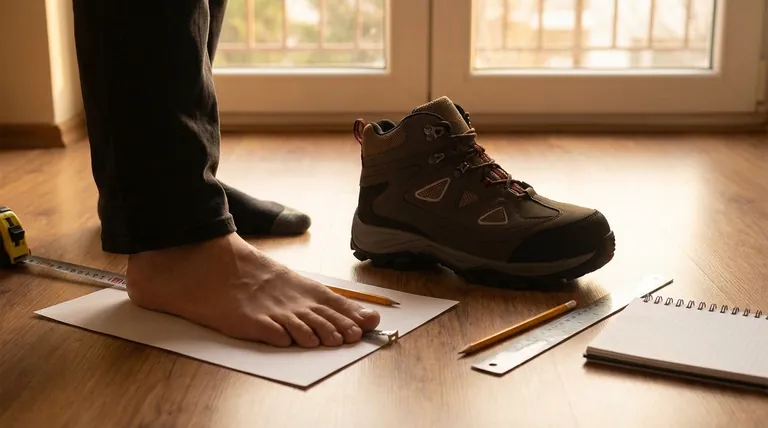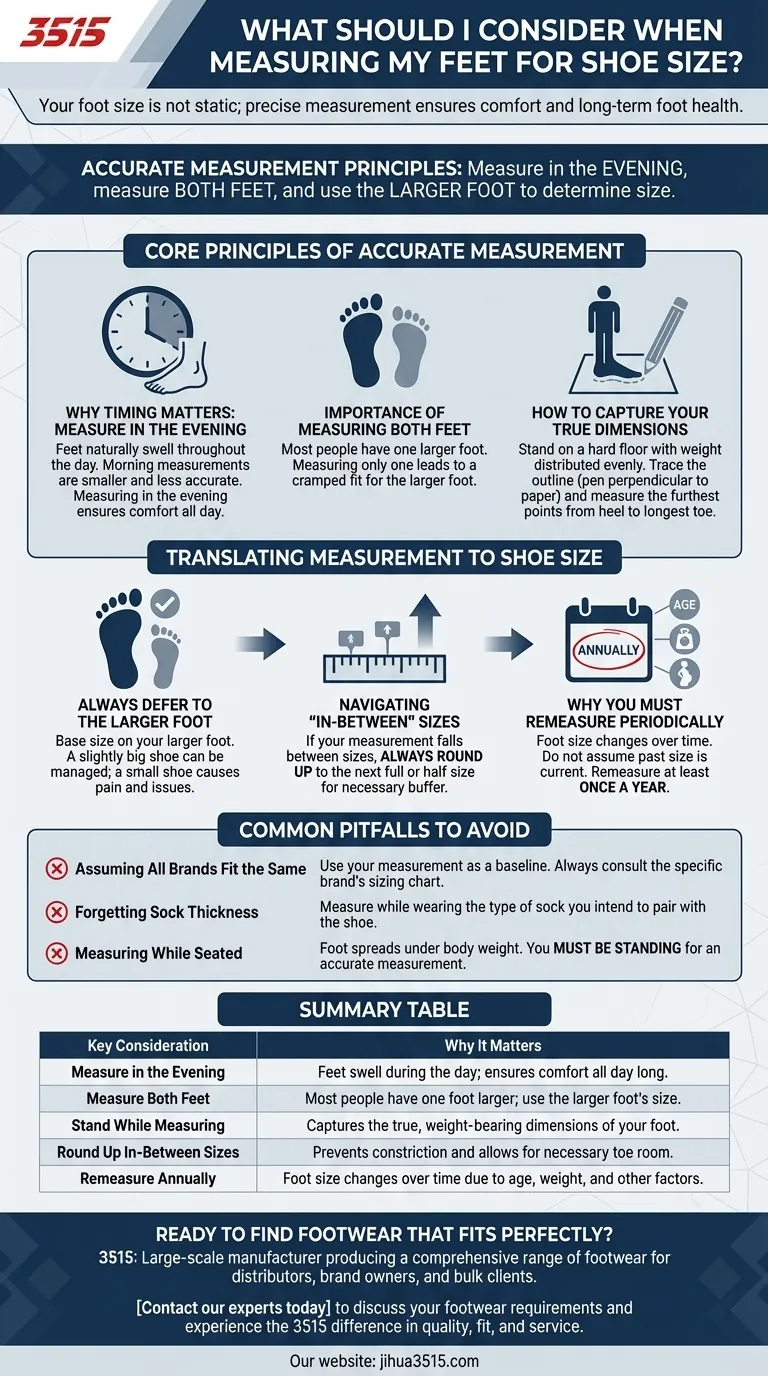To accurately measure your feet for shoe size, you must measure them at the end of the day when they are at their largest. It is critical to measure both feet, as they are often slightly different sizes, and always use the measurement of the larger foot to determine your size.
Your foot size is not a static number; it changes throughout the day and over the years. Adopting a precise measurement process is the only way to guarantee a proper fit, which is fundamental to your comfort and long-term foot health.

The Core Principles of Accurate Measurement
Understanding why specific steps are necessary is key to getting a reliable measurement. The goal is to capture your foot's true, weight-bearing dimensions.
Why Timing Matters: Measure in the Evening
Your feet naturally swell and expand throughout the day due to gravity and activity.
Measuring in the morning will give you a smaller, less accurate reading. By measuring in the evening, you are sizing for your foot at its largest, ensuring comfort from morning to night.
The Importance of Measuring Both Feet
Most people have one foot that is slightly larger than the other. This is a normal anatomical variation.
Failing to measure both feet often leads to choosing a size that fits the smaller foot, causing the larger foot to be cramped and uncomfortable.
How to Capture Your True Dimensions
Place a piece of paper on a hard floor and stand on it. It's important that your foot is flat and you are distributing your weight evenly.
Have someone else trace the outline of your foot, or carefully do it yourself, keeping the pen or pencil perpendicular to the paper. Measure the length from the furthest point of your heel to the tip of your longest toe.
Translating Measurement to Shoe Size
Once you have your raw measurements in inches or centimeters, you need to correctly interpret them to find your size.
Always Defer to the Larger Foot
The golden rule is to base your shoe size on your larger foot.
A shoe that is slightly too big can often be managed with thicker socks or an insole, but a shoe that is too small will cause pain, blisters, and potential long-term foot problems.
Navigating "In-Between" Sizes
If your measurement falls between two sizes on a sizing chart, always round up to the next full or half size.
This provides a necessary buffer and prevents the constriction that comes from a shoe that is even marginally too short.
Why You Must Remeasure Periodically
Foot size and shape can change over time due to factors like age, weight changes, and pregnancy.
Do not assume the size you wore five years ago is still your correct size. Measuring your feet at least once a year is a crucial practice for maintaining foot health.
Common Pitfalls to Avoid
Even with the right principles, small mistakes can lead to an incorrect size. Being aware of these common errors is essential.
Pitfall: Assuming All Brands Fit the Same
A measurement provides your true foot size, but it does not account for manufacturing variations between brands. Use your measurement as a baseline, and always consult the specific brand's sizing chart.
Pitfall: Forgetting Sock Thickness
The socks you wear can significantly impact a shoe's fit. Measure your feet while wearing the type of sock you would typically pair with the shoe you intend to buy.
Pitfall: Measuring While Seated
Measuring while sitting down does not account for how your foot spreads and lengthens under your body weight. You must be standing to get an accurate, weight-bearing measurement.
Making the Right Choice for Your Foot Health
Use your accurate measurement to make an informed decision based on your specific needs.
- If your primary focus is everyday comfort: Always measure in the evening and purchase the size that corresponds to your larger foot, rounding up if necessary.
- If your primary focus is a performance fit for athletic shoes: Measure while wearing your preferred athletic socks and pay close attention to the specific sizing guide for that brand, as performance fits can vary.
- If your primary focus is avoiding foot-related health issues: Commit to remeasuring your feet annually to account for natural changes and ensure you are always wearing a supportive, correctly sized shoe.
Taking control of your shoe fit begins with a precise and consistent measurement of your own feet.
Summary Table:
| Key Consideration | Why It Matters |
|---|---|
| Measure in the Evening | Feet swell during the day; ensures comfort all day long. |
| Measure Both Feet | Most people have one foot larger; use the larger foot's size. |
| Stand While Measuring | Captures the true, weight-bearing dimensions of your foot. |
| Round Up In-Between Sizes | Prevents constriction and allows for necessary toe room. |
| Remeasure Annually | Foot size changes over time due to age, weight, and other factors. |
Ready to find footwear that fits perfectly?
As a large-scale manufacturer, 3515 produces a comprehensive range of footwear for distributors, brand owners, and bulk clients. Our production capabilities encompass all types of shoes and boots, ensuring you get the exact size and style you need for your customers or yourself.
Contact our experts today to discuss your footwear requirements and experience the 3515 difference in quality, fit, and service.
Visual Guide

Related Products
- Safety Footwear Wholesale Manufacturer for Custom OEM/ODM Production
- Durable Rubber-Soled Utility Shoes for Wholesale & Custom Brand Manufacturing
- Wholesale Safety Footwear Manufacturer for Bulk & Custom OEM Orders
- Wholesale Comfortable Business Casual Shoes Custom Manufacturing
- Wholesale Leather Safety Boots with Customizable Protective Toe
People Also Ask
- Is safety-toe as good as steel toe? Choose the Right Protection for Your Job
- Is it normal to wear shoes in the house? A Guide to Hygiene, Comfort & Culture
- What are OSHA approved shoes? Understanding the Correct Standards for Workplace Safety
- What cultural and environmental considerations are tied to wearing shoes indoors? Balance Hygiene, Tradition, and Foot Health
- What do heavy duty boots do? Protect Your Feet in Demanding Work Environments



















